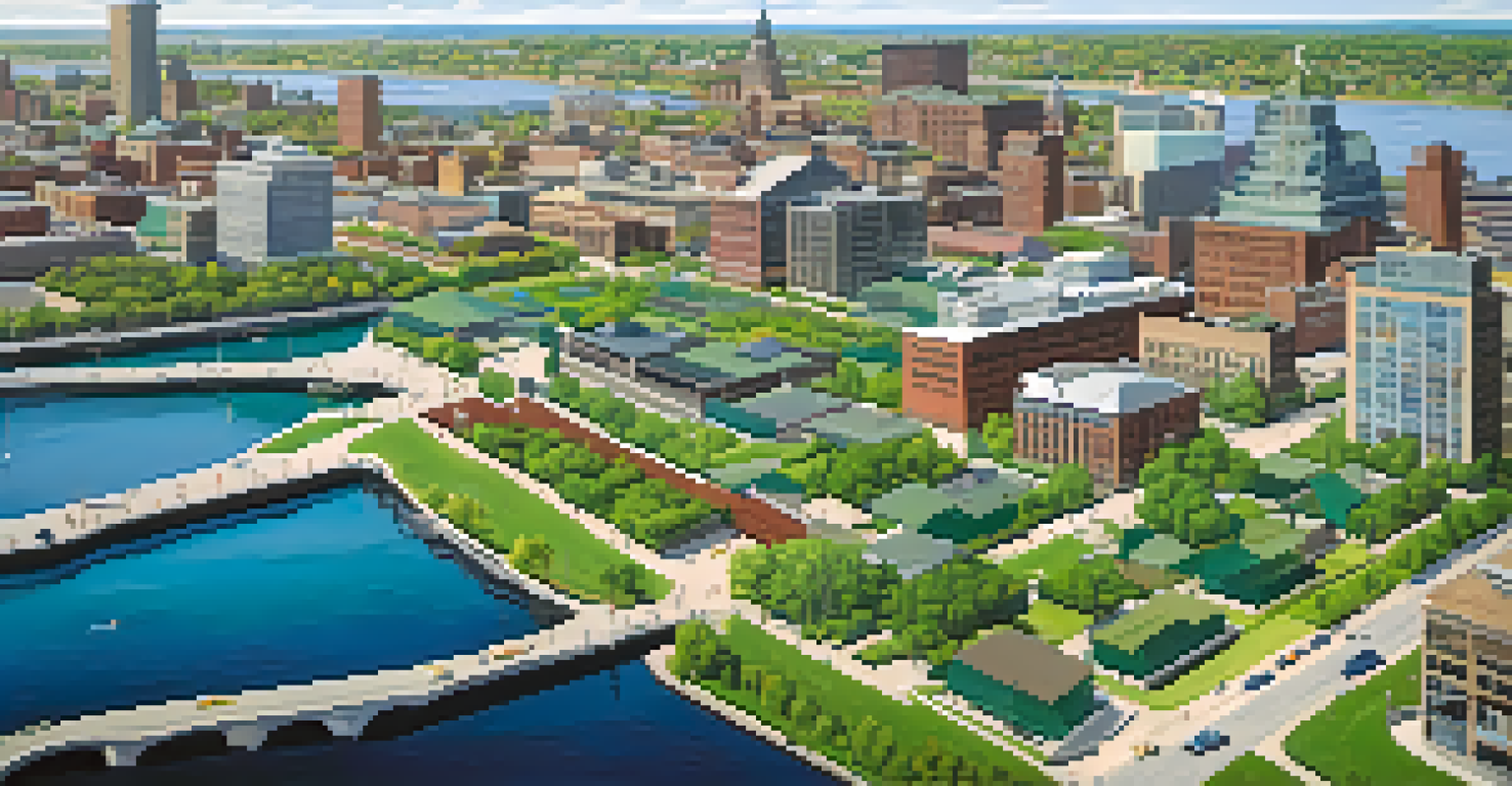Sustainable Practices in Buffalo's Waterfront Development

The Importance of Sustainable Waterfront Development
Sustainable waterfront development is crucial for balancing environmental needs with urban growth. It focuses on creating spaces that promote ecological health while enhancing community engagement. In Buffalo, this approach helps transform the waterfront into a vibrant hub for residents and visitors alike.
We won't have a society if we destroy the environment.
By prioritizing sustainability, Buffalo aims to protect its unique ecosystems while providing recreational areas. This means considering the impact of development on local wildlife and water quality. The goal is to create spaces that not only serve people but also nurture the environment.
Moreover, sustainable practices in waterfront development contribute to the city's resilience against climate change. With rising water levels and increased storms, it's essential for the waterfront to withstand these challenges. Buffalo's commitment to sustainability ensures a safe and inviting space for everyone.
Innovative Green Infrastructure in Buffalo
Buffalo is embracing innovative green infrastructure to enhance its waterfront. This includes rain gardens, permeable pavements, and green roofs that help manage stormwater effectively. By allowing rainwater to soak into the ground, these features reduce flooding and improve water quality.

One notable example is the use of bioswales along the waterfront. These landscaped areas collect and filter stormwater, providing natural drainage while adding aesthetic value. They not only beautify the landscape but also support local biodiversity by providing habitats for various species.
Community Engagement Drives Success
Active participation from local residents in planning ensures waterfront spaces meet community needs and foster a sense of belonging.
Such green infrastructure practices not only mitigate environmental issues but also create inviting spaces for community use. They encourage residents to engage with their surroundings, fostering a sense of ownership and pride. In turn, this strengthens the community's commitment to sustainability.
Community Engagement in Waterfront Projects
Community involvement is a cornerstone of Buffalo's waterfront development strategy. Local residents are encouraged to participate in planning and decision-making processes, ensuring their voices are heard. This collaborative approach helps create spaces that truly reflect the community's needs and desires.
The environment is where we all meet; where we all have a mutual interest; it is the one thing all of us share.
Workshops and public meetings are often organized to gather input from diverse groups. This engagement not only builds trust but also fosters a sense of belonging among residents. When people feel connected to a project, they are more likely to support and maintain it.
Additionally, community-led initiatives often focus on educational programs about sustainability. These programs empower locals to take action in their daily lives, reinforcing the importance of preserving the waterfront for future generations. It's a win-win for both the community and the environment.
The Role of Local Businesses in Sustainability
Local businesses play a vital role in supporting sustainable waterfront development in Buffalo. By adopting eco-friendly practices, they contribute to the overall health of the community and environment. Initiatives like sourcing materials locally and minimizing waste can significantly impact the sustainability of waterfront projects.
Many businesses are also involved in sponsoring community events focused on environmental education. These events not only raise awareness but also promote a culture of sustainability. When local entrepreneurs share their stories and practices, it inspires others to follow suit.
Sustainable Practices Protect Ecosystems
Implementing green infrastructure and protecting natural habitats are vital for maintaining ecological balance and enhancing urban resilience.
Furthermore, collaboration between businesses and local governments can lead to innovative solutions. Partnerships can drive investment in sustainable technologies, making Buffalo's waterfront a model for other cities. Together, they can create a thriving economy while protecting the environment.
Protecting Natural Habitats Along the Waterfront
An essential aspect of Buffalo's waterfront development is the protection of its natural habitats. Efforts are being made to preserve wetlands and other ecosystems that provide critical services to the community. These areas act as buffers against flooding and support a diverse array of wildlife.
Restoration projects have been launched to rehabilitate degraded habitats, ensuring that local flora and fauna can thrive. By reconnecting the community with nature, these initiatives foster a deeper appreciation for the environment. It’s about creating a balance between urban development and ecological preservation.
Additionally, educational programs highlight the importance of these natural habitats. Engaging the community in conservation efforts helps cultivate stewardship and responsibility towards the environment. This collective effort ensures that Buffalo's waterfront remains a vibrant and healthy space for all.
The Impact of Climate Change on Waterfront Development
Climate change poses significant challenges for waterfront development in Buffalo. Rising water levels and increased storm severity threaten the integrity of the waterfront. Addressing these issues requires innovative solutions and forward-thinking strategies that prioritize sustainability.
Buffalo is actively integrating climate resilience into its development plans. This includes designing structures with adaptive features that can withstand extreme weather. By anticipating future challenges, the city aims to protect both its infrastructure and the natural environment.
Climate Change Shapes Future Planning
Buffalo is integrating climate resilience into waterfront development to address rising water levels and severe storms effectively.
Furthermore, public awareness campaigns about climate change are crucial in driving community action. Educating residents on the impacts of climate change fosters a proactive mindset. Together, the community can work towards a more sustainable future, ensuring the waterfront remains a cherished resource.
Future Trends in Sustainable Waterfront Development
Looking ahead, Buffalo's waterfront development is set to embrace exciting trends in sustainability. Innovations in renewable energy, such as solar panels and wind turbines, are becoming more prominent. These technologies can power waterfront facilities while reducing carbon footprints.
Additionally, smart technology is playing a role in enhancing sustainability efforts. From smart lighting to real-time monitoring of environmental conditions, these advancements allow for efficient resource management. This tech-savvy approach not only improves sustainability but also enhances the user experience.

Finally, as more cities adopt sustainable practices, Buffalo has the opportunity to lead the way. By sharing its successes and lessons learned, the city can inspire others to prioritize sustainability in their waterfront projects. The future looks bright for Buffalo's waterfront, and it's a journey worth watching.